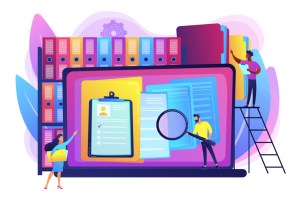The third-party data your customers give you is a gift to your business that will keep on giving – you just need to know how to ask for it.
Unlike second-party data that you purchase through a marketplace, or third-party data that is collected and aggregated via web site cookies, zero-party data represents a huge opportunity to personalize the way you develop a relationship with your customers. It even goes beyond first-party data that you might have been collecting all along.
While first-party data such as website visits can provide incredible insights, it can take time and considerable effort to get at them. Think of first-party data as the raw material, such as coal, that has to be refined – or in this case, analyzed – in order to produce a diamond.
In contrast, zero-party data is like panning for gold. When you discover it, the value is already there. In other words, this is data in which customers are giving explicit information about their preferences, interests, pain points, and expectations of your brand.
Zero-party data is gold because it is unambiguously providing information customers want you to know. You may need to make some inferences and ask them for more details to draw the right conclusions, but it’s like a direct line to your audience compared with other forms of data acquisition.
Companies haven’t always invested in first-party data collection because it can require more of an internal lift. There are many established services and providers of second and third-party data. In fact, Salesforce’s most recent State of Marketing Report found 75% of brands are still relying upon second and third-party data. With privacy concerns and regulations on the rise, that may not be viable for much longer.
Zero-party data depends on setting up consistent and customer-friendly processes to get the right quantity and quality of responses. Any company can do it, though, and it’s critical to gather every source of customer data you can find.
Once you see the range of options available, there’s no reason to put off collecting first-party data anymore. It should be a business imperative as you build a customer experience based on trusted input.
1. Build feedback into the customer journey
In large businesses, it’s common to have contact centre agents wrap up a call by asking customers a few standard questions about how well the interaction went. Small and medium-sized businesses (SMBs) can do the same thing through digital channels from the moment customers make a purchase to long afterwards.
Think about how you could set up feedback forms, for example, when customers finalize their checkout on an e-commerce purchase. Were there items they were looking for but couldn’t find? That could inform the range of products you keep in stock. How did they hear about you? Their answers will show which marketing channels to prioritize. Would they recommend you to friends and family? A brief testimonial could do lots for your reputation.
You can create similar feedback forms that are served up via email after they’ve made a purchase to see how they’re enjoying the product and their experience, or at any point where they might be ready to share their thoughts.
2. Go deeper with one-on-one interviews
It doesn’t matter whether or not they have a huge following on social media services like Instagram or TikTok. Your customers are the true influencers, because their peers can often relate to their feelings and experiences. That makes taking the time to practice some active listening with some of them a powerful opportunity for brands.
Look through your existing data to identify a handful of your most loyal customers, or those who seem to make significant purchases. Let them know how grateful you are for their business, and ask them whether they’d be willing to take a few minutes to discuss their experience on a brief call.
These interviews can delve into the good, the bad and the ugly from a customer experience perspective. You can also get a sense of what makes each customer unique, which can ensure you segment your database with greater precision.
If this sounds like a lot of work, consider how you might be able to repurpose these interviews as marketing content. Ask their permission first, of course, but depending on how they go, some of this first-party data could become fodder for your best-performing blog posts, or even the basis of a podcast.
3. Invite customers to a preference centre
Why do people love services like Facebook? Easy – it’s a way for them to build highly personal curations of their photos, videos and favourite moments throughout their lives. It’s like a living diary, except it’s open to their family and friends. Preference centres offer similar benefits to your customers.
Rather than guessing at what customers will want, preference centers act as a digital hub where they can provide zero-party data to their heart’s content. This includes what products they tend to buy from you, and items that they’ve put on their wish list for later. They can clearly spell out what kind of items they buy for themselves, and when they come to your business looking to buy a gift.
A good preference centre also helps clarify the best ways to communicate with customers, which is essential to a healthy relationship. You’ll know whether they want to get email, a text message or even direct mail. They’ll spell out areas or subjects where they’d rather not be contacted. The best part is that if they change their minds at any time, updating it in the preference centre is just a few clicks away.
These are by no means the only ways to collect first-party data, but they’re three sure-fire ways to get started. Your goal should be to have a mix of mechanisms for getting specific insights on a set timeline (which can help with a marketing campaign) and those like a preference centre that are evergreen sources of constantly updated first-party data.
This is the moment to begin collecting first-party data – and potentially gain a first-mover advantage in developing a more personalized approach to marketing.

























